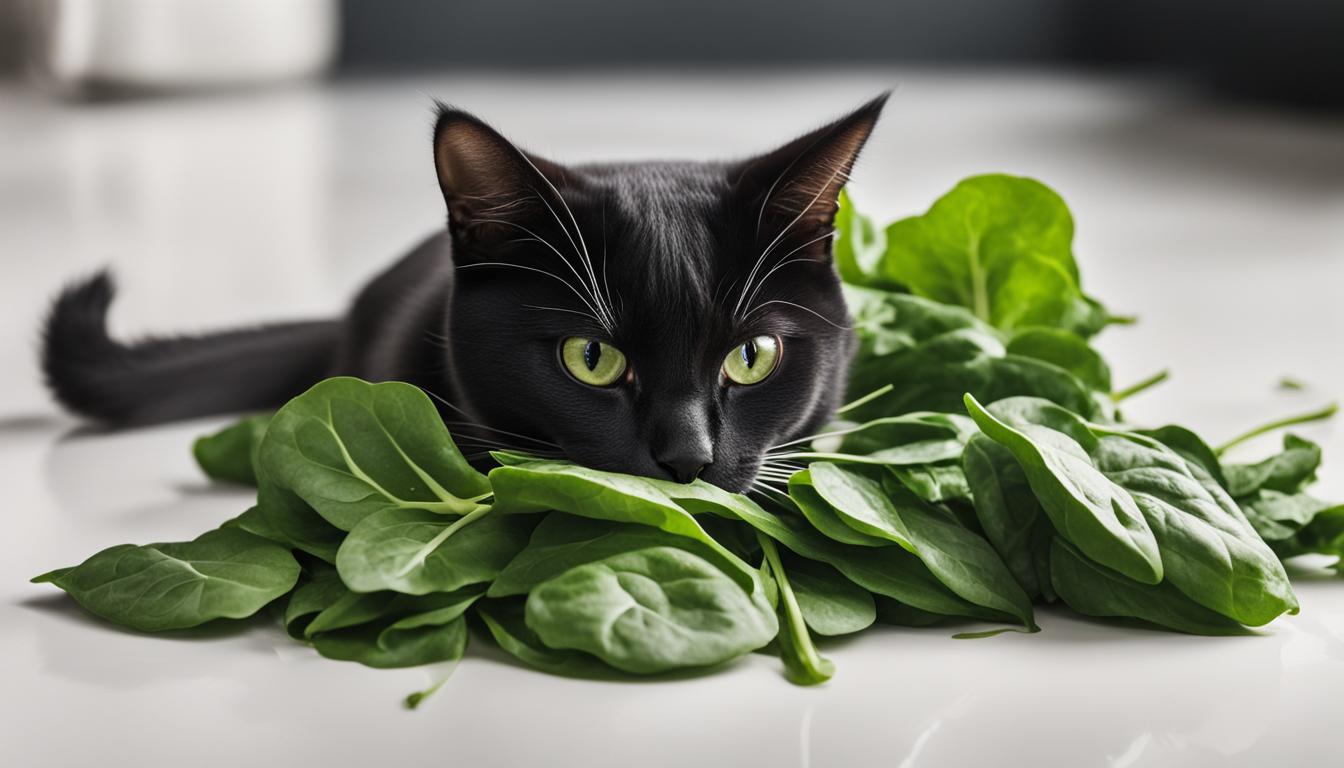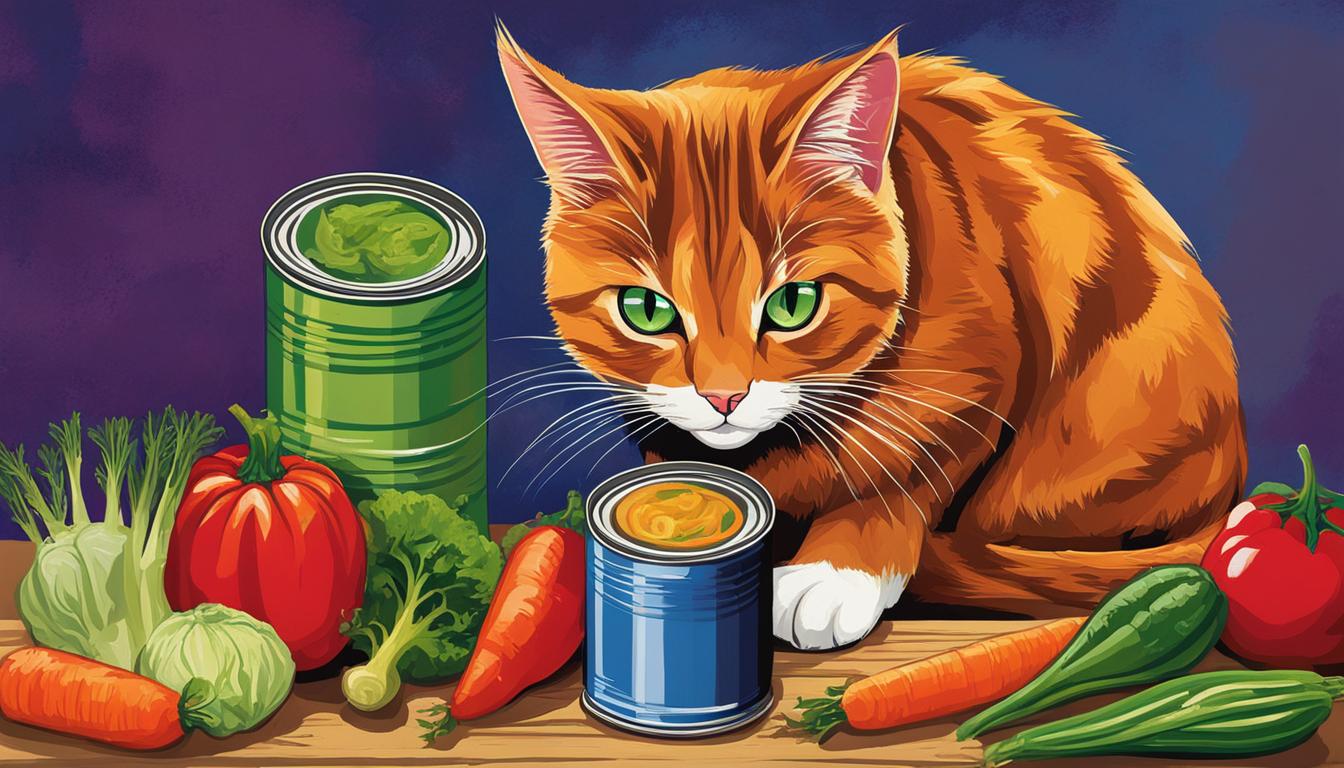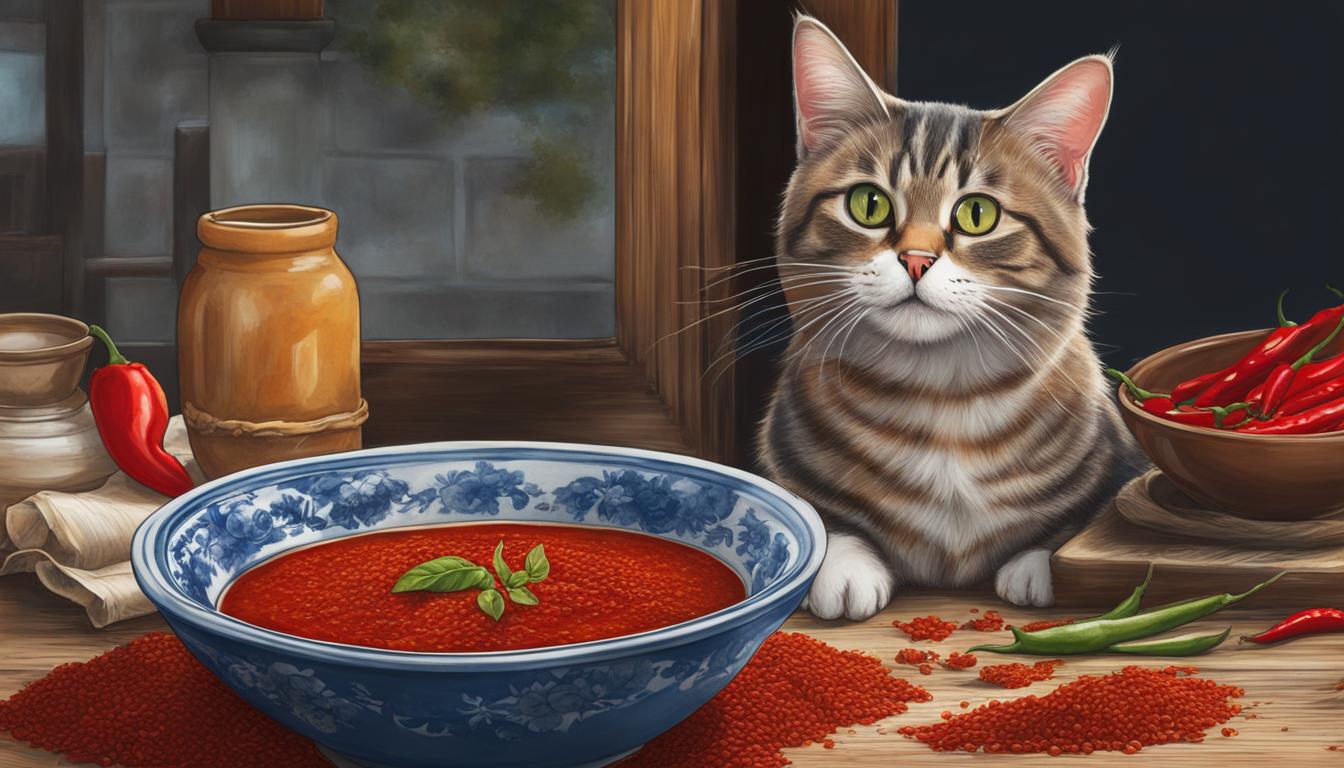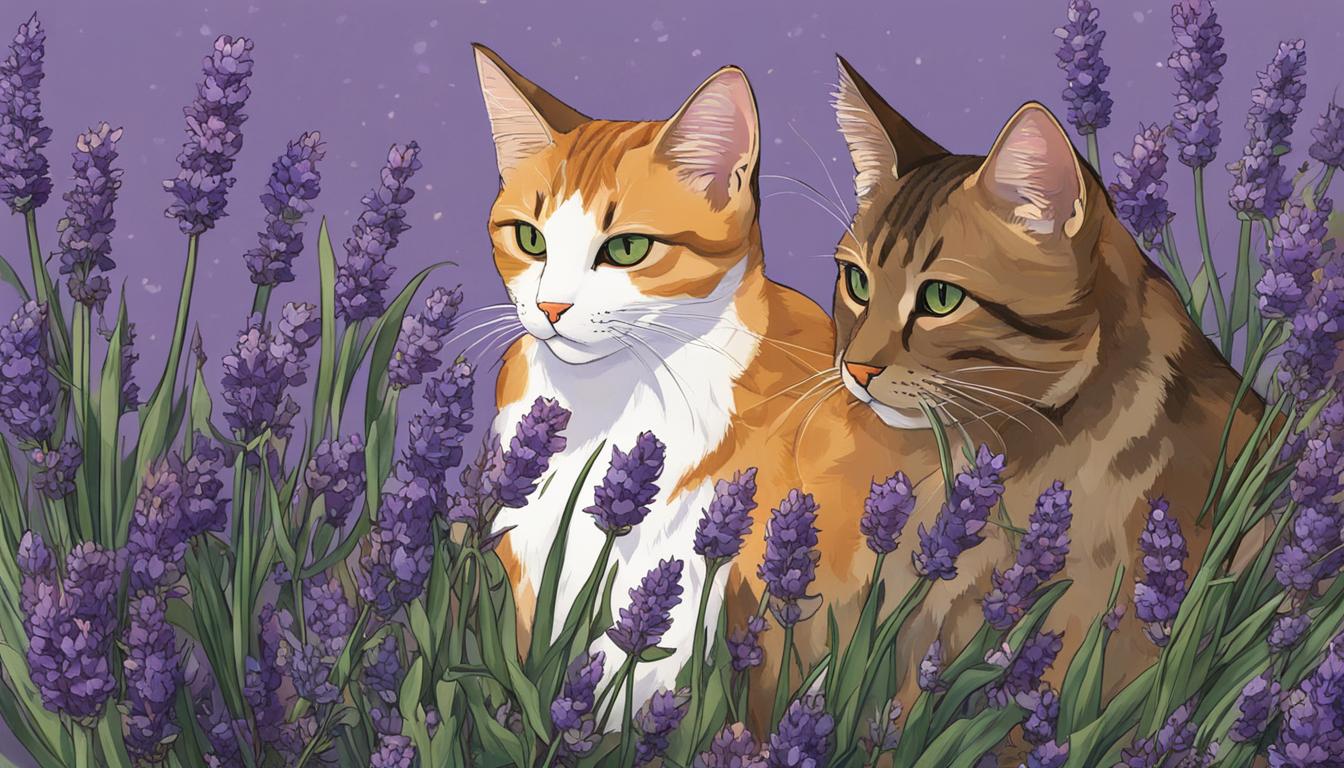As a curious cat owner, I often find myself wondering about the dietary needs of our feline friends. Lately, I’ve been pondering whether cats can munch on leafy greens like spinach and kale. After all, veggies are packed with nutrients, so why not share the goodness? Join me on this journey as we explore whether cats can enjoy these vibrant greens and uncover the potential benefits and risks.
Before delving into the topic, it’s crucial to note that cats are obligate carnivores. Their bodies are designed to thrive on a meat-based diet to fulfill their energy and protein needs. However, incorporating small amounts of vegetables into their diet can provide additional fiber and phytonutrients.
Key Takeaways:
- Spinach and kale can be safe for cats to eat in moderation, but they should not make up a significant portion of their diet.
- Cats with kidney or urinary problems should avoid spinach due to its calcium oxalate content.
- Consult with a veterinarian before adding spinach or kale to a cat’s diet.
- Cats primarily require animal-based proteins, and vegetables are not necessary for their diet.
- Spinach contains vitamins A, K, B6, B2, and E, as well as minerals like magnesium, folate, calcium, and potassium.
Are Vegetables Necessary for Cats’ Diets?
Cats have specific dietary needs as obligate carnivores, requiring a diet primarily based on meat. While vegetables like spinach and kale can provide some nutritional benefits, they are not necessary for a cat’s diet. Cats need energy and protein from animal sources, and their digestive systems are not well-suited for digesting and utilizing plant-based nutrients. It is essential to provide cats with a balanced, high-quality cat food that meets all their nutritional requirements. Adding small amounts of vegetables to their diet can be done as an occasional treat but should not replace their main cat food.
Unlike humans and some other animals, cats lack the specific enzymes necessary to efficiently break down and absorb nutrients from plant matter. Their digestive systems are designed to process and derive nutrients from animal proteins. While cats may nibble on grass or small amounts of leafy greens, this behavior is primarily for purging hairballs or aiding digestion and not for meeting their nutritional needs.
Feeding cats a diet solely based on vegetables can result in nutrient deficiencies, particularly in essential amino acids like taurine and arginine, which are critical for a cat’s overall health. These amino acids are found primarily in animal tissues and are necessary for various bodily functions, including proper heart function, vision, and the production of important hormones and enzymes.
“Cats are obligate carnivores, which means their nutritional requirements are best met through a diet rich in animal-based proteins. While small amounts of vegetables can provide some added fiber and phytonutrients, they are not a necessary component of a cat’s diet.”
| Nutrient | Importance for Cats | Main Sources |
|---|---|---|
| Taurine | Essential for heart health, vision, and reproductive function | Animal tissues, especially organs like liver and heart |
| Arginine | Involved in the detoxification process and the production of important hormones and enzymes | Animal tissues, especially organs like liver and kidney |
| Vitamin A | Supports good vision and a healthy immune system | Animal liver, fish oil |
| Vitamin B12 | Essential for proper nervous system function and the production of red blood cells | Meat, eggs, fish |
| Protein | Provides essential amino acids for growth, tissue repair, and energy | Meat, poultry, fish |
Health Benefits of Spinach for Cats
Spinach can offer cats certain health benefits when consumed in small amounts. It is rich in vitamins A, K, B6, B2, and E, which support various body functions. Vitamin A promotes good vision and a healthy immune system, while vitamin K plays a role in blood clotting. B vitamins are essential for metabolism and energy production, and vitamin E acts as an antioxidant. Spinach also contains minerals like magnesium, folate, calcium, and potassium, which contribute to overall health. However, it is important to remember that cats should obtain most of their nutrients from animal sources.
The Nutritional Content of Spinach for Cats
To provide a clearer understanding of the nutritional content of spinach for cats, the table below breaks down the vitamins and minerals found in this leafy green.
| Nutrient | Amount per 100g |
|---|---|
| Vitamin A | 469 IU |
| Vitamin K | 483.6 mcg |
| Vitamin B6 | 0.2 mg |
| Vitamin B2 | 0.2 mg |
| Vitamin E | 2.0 mg |
| Magnesium | 79 mg |
| Folate | 194 mcg |
| Calcium | 99 mg |
| Potassium | 558 mg |
As shown in the table, spinach contains a range of essential vitamins and minerals that can contribute to a cat’s overall health. However, it should be emphasized that these nutrients should not replace a cat’s primary source of nutrition, which should come from a balanced and complete diet of high-quality cat food.
Cooking Leafy Greens for Your Cat: Safe and Cat-Friendly Methods
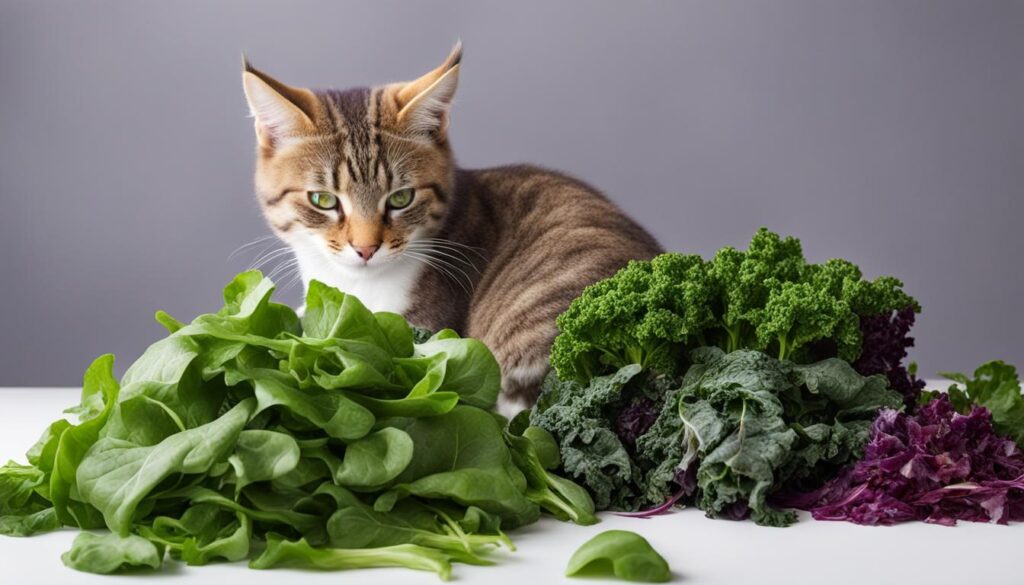
When it comes to feeding leafy greens like spinach or kale to your feline friend, proper preparation is key. Cats have sensitive digestive systems, so it’s important to cook the greens in a way that makes them easily digestible and safe for your cat to consume. By using cat-friendly cooking methods, you can ensure that your cat can enjoy the nutritional benefits of leafy greens without any harm.
One safe and cat-friendly method of cooking leafy greens for your cat is to lightly steam them. Steaming helps to soften the vegetables’ cell membranes, making the nutrients more accessible to your cat’s body. To steam leafy greens like spinach or kale, simply mince or finely chop them and steam for about 30 to 50 seconds. This quick steaming process retains the nutrients while ensuring that the greens are easy for your cat to eat and digest. It’s important to note that overcooking can destroy some nutrients, so it’s best to keep the steaming time short.
It’s crucial to avoid adding any seasoning, spices, or salt to the cooked leafy greens as these can be harmful to cats. Cats have different taste preferences than humans, and certain seasonings that we enjoy can be toxic to them. Therefore, it’s best to keep the cooked greens plain and free of any additives. By following these cat-friendly cooking methods, you can safely introduce leafy greens like spinach or kale to your cat’s diet and provide them with additional fiber and phytonutrients.
Benefits of Steaming Leafy Greens for Cats
Steaming leafy greens for cats is a beneficial way to retain the nutrients while making them softer and more easily digestible.
| Nutrient | Benefits |
|---|---|
| Vitamins A, K, B6, B2, E | Support various body functions, such as vision, immune health, metabolism, and antioxidant protection. |
| Minerals (magnesium, folate, calcium, potassium) | Promote overall health and contribute to proper bodily functions. |
| Fiber and Phytonutrients | Provide additional health benefits, including improved digestion and potential antioxidant effects. |
By steaming leafy greens, you can help preserve these essential vitamins and minerals, ensuring that your cat receives the maximum nutritional benefits from consuming them. Remember to introduce leafy greens gradually into your cat’s diet and consult with a veterinarian if you have any concerns or questions.
Risks and Considerations of Leafy Greens for Cats
While small amounts of leafy greens like spinach and kale can be safe for cats, it is important to be aware of potential risks and considerations. Some cats may develop allergies to certain vegetables, including leafy greens. Therefore, it is crucial to monitor their reaction when introducing new foods and consult a veterinarian if any adverse symptoms occur. Allergic reactions may manifest as digestive issues, skin irritations, or respiratory problems. It is always best to err on the side of caution and seek professional advice.
Collard greens, while generally safe for humans, can pose specific risks for cats, especially those with kidney or urinary issues. Collard greens have a higher calcium content, which can potentially lead to the formation of urinary stones in susceptible cats. If your cat has a history of kidney or urinary problems, it is advisable to avoid feeding them collard greens or any other high-calcium vegetables.
In general, it is essential to remember that cats are obligate carnivores and have specific dietary needs. While leafy greens can provide some additional vitamins and minerals, they should only be offered as occasional treats or additions to homemade recipes. It is crucial to consult with a veterinarian before introducing any new foods to a cat’s diet, especially for kittens or cats with specific health conditions. Your veterinarian can advise you on the appropriate amounts and types of leafy greens that are safe for your cat.
Table: Leafy Greens Considerations for Cats
| Leafy Greens | Risks/Considerations |
|---|---|
| Spinach | Potential for allergies. Cats with kidney or urinary problems should avoid due to calcium oxalate content. |
| Kale | Potential for allergies. Cats with kidney or urinary problems should avoid due to high calcium content. |
| Collard Greens | High calcium content may pose a risk for cats with kidney or urinary issues. Best to avoid. |
Remember, your cat’s health and well-being should always come first. It is crucial to provide them with a balanced and appropriate diet that meets their specific nutritional needs. If you are unsure about incorporating leafy greens into your cat’s diet, consult with a veterinarian for personalized guidance and recommendations.

Homemade Treats and Recipes with Leafy Greens for Cats
As a devoted cat owner, I’m always looking for ways to treat my feline friend with healthy and delicious snacks. Incorporating leafy greens like spinach and kale into homemade treats and recipes can be a fun and nutritious option. Here, I’ll share some ideas and recipes for homemade leafy green cat treats that your furry companion will love.
Leafy Green Cat Treats
Creating homemade leafy green cat treats is a simple and rewarding experience. Start by finely chopping spinach or kale and combining it with cat-friendly ingredients such as canned tuna or chicken broth. Mix in whole wheat flour or oats to form a dough, then shape small bite-sized treats and bake them in the oven until golden brown.
These homemade treats are a great way to introduce small amounts of leafy greens into your cat’s diet. Remember to offer them in moderation, as leafy greens should not make up a significant portion of their overall food intake. Always consult with your veterinarian if you have any concerns about introducing new ingredients into your cat’s diet.
Leafy Green-Based Cat Food Recipes
If you’re feeling adventurous, you can also create homemade cat food recipes that incorporate leafy greens. One option is to blend steamed spinach or kale with cooked chicken or fish, adding a small amount of water or broth for consistency. This creates a balanced meal that provides the nutritional benefits of leafy greens along with animal-based proteins.
Remember, when preparing homemade cat food, it’s crucial to ensure that the recipe meets all of your cat’s nutritional needs. Consult with a veterinarian or a professional in pet nutrition to create appropriate recipes that include small amounts of leafy greens.
With these homemade treats and recipes, you can add a nutritious twist to your cat’s diet while providing them with tasty snacks they’ll adore. Just remember to keep portions small and consult with your veterinarian to ensure your cat’s diet remains balanced and healthy.
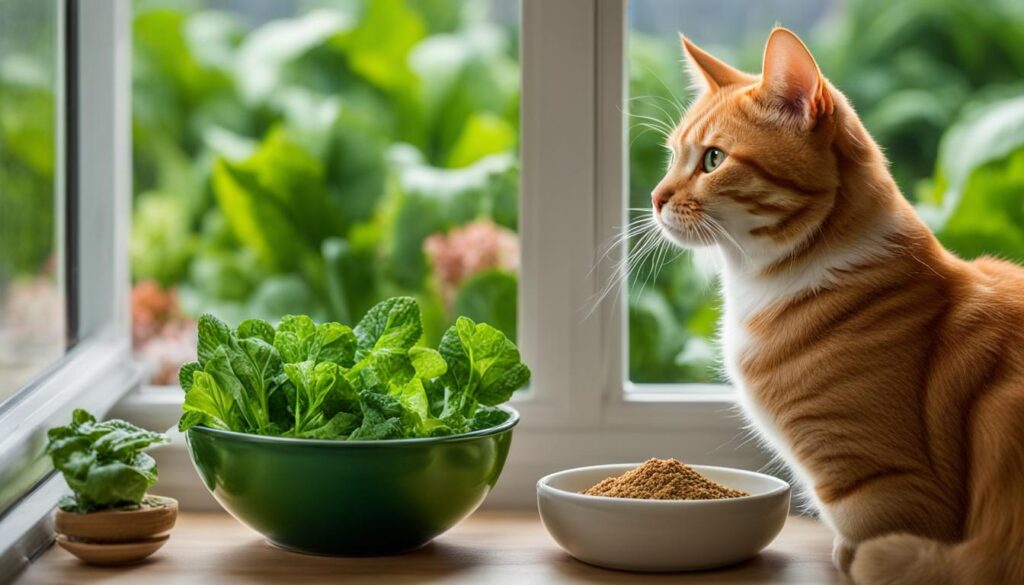
The Role of Leafy Greens in a Cat’s Diet
As a curious cat owner, I often wonder about the role of leafy greens in my feline friend’s diet. Can kittens eat spinach? Are leafy greens beneficial for cats? Let’s explore the topic of integrating vegetables into a cat’s diet.
First and foremost, it’s essential to understand that leafy greens like spinach and kale are not necessary for a cat’s diet. Cats are obligate carnivores, meaning their bodies are designed to thrive on meat-based proteins. However, small amounts of leafy greens can be safe for cats as an occasional addition or treat.
Leafy greens, such as spinach, can provide cats with some additional vitamins and minerals. They contain nutrients like vitamins A, K, B6, B2, and E, as well as minerals like magnesium, folate, calcium, and potassium. While these nutrients can contribute to overall health, they should not replace the primary nutritional needs that are met through high-quality cat food.
When considering integrating leafy greens into your cat’s diet, it’s crucial to consult with a veterinarian. They can assess your cat’s specific dietary requirements and determine if leafy greens are suitable for their needs. This is especially important for kittens and cats with specific health conditions that may require a tailored diet.
FAQ
Can cats eat spinach or kale?
Yes, cats can eat spinach and kale in moderation. However, leafy greens should not be a significant part of their diet.
Are vegetables necessary for cats’ diets?
No, cats are obligate carnivores and primarily require meat for their nutritional needs. While vegetables can provide some benefits, they are not essential for cats.
What are the health benefits of spinach for cats?
Spinach is rich in vitamins A, K, B6, B2, and E, as well as minerals like magnesium, folate, calcium, and potassium. These nutrients support various body functions in cats.
How should leafy greens be prepared for cats?
Leafy greens like spinach or kale should be minced or finely chopped and lightly steamed for 30 to 50 seconds to make them more digestible for cats.
Are there any risks or considerations when feeding leafy greens to cats?
Cats can develop allergies to certain vegetables, including leafy greens. Additionally, cats with kidney or urinary problems should avoid spinach due to its calcium oxalate content.
Can cats have homemade treats or recipes with leafy greens?
Yes, homemade cat treats or recipes with small amounts of leafy greens can be given to cats as occasional treats. However, it is important to ensure a balanced diet that meets all their nutritional needs.
What role do leafy greens play in a cat’s diet?
Leafy greens should not be a significant part of a cat’s diet. Cats are obligate carnivores and should primarily obtain their nutrients from animal-based proteins.

